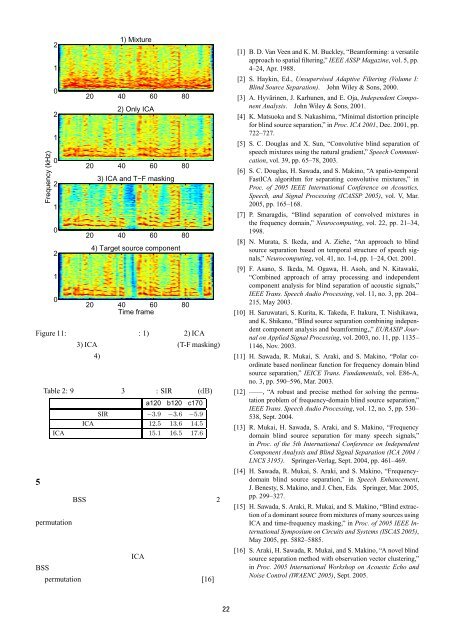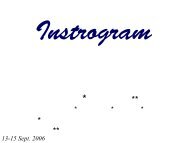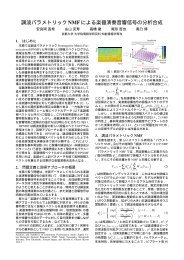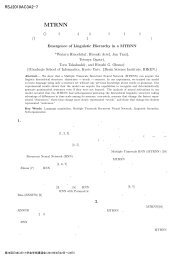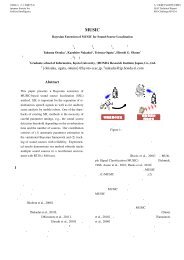第22回 ロボット聴覚特集 - 奥乃研究室 - 京都大学
第22回 ロボット聴覚特集 - 奥乃研究室 - 京都大学
第22回 ロボット聴覚特集 - 奥乃研究室 - 京都大学
Create successful ePaper yourself
Turn your PDF publications into a flip-book with our unique Google optimized e-Paper software.
Frequency (kHz)2102102102101) Mixture20 40 60 802) Only ICA20 40 60 803) ICA and T−F masking20 40 60 804) Target source component20 40 60 80Time frameFigure 11: : 1)2) ICA 3) ICA (T-F masking)4) Table 2: 9 3 : SIR (dB) a120 b120 c170 SIR −3.9 −3.6 −5.9ICA 12.5 13.6 14.5ICA 15.1 16.5 17.65 BSS 2permutation ICA BSS permutation [16][1] B. D. Van Veen and K. M. Buckley, “Beamforming: a versatileapproach to spatial filtering,” IEEE ASSP Magazine, vol. 5, pp.4–24, Apr. 1988.[2] S. Haykin, Ed., Unsupervised Adaptive Filtering (Volume I:Blind Source Separation). John Wiley & Sons, 2000.[3] A. Hyvärinen, J. Karhunen, and E. Oja, Independent ComponentAnalysis. John Wiley & Sons, 2001.[4] K. Matsuoka and S. Nakashima, “Minimal distortion principlefor blind source separation,” in Proc. ICA 2001, Dec. 2001, pp.722–727.[5] S. C. Douglas and X. Sun, “Convolutive blind separation ofspeech mixtures using the natural gradient,” Speech Communication,vol. 39, pp. 65–78, 2003.[6] S. C. Douglas, H. Sawada, and S. Makino, “A spatio-temporalFastICA algorithm for separating convolutive mixtures,” inProc. of 2005 IEEE International Conference on Acoustics,Speech, and Signal Processing (ICASSP 2005), vol. V, Mar.2005, pp. 165–168.[7] P. Smaragdis, “Blind separation of convolved mixtures inthe frequency domain,” Neurocomputing, vol. 22, pp. 21–34,1998.[8] N. Murata, S. Ikeda, and A. Ziehe, “An approach to blindsource separation based on temporal structure of speech signals,”Neurocomputing, vol. 41, no. 1-4, pp. 1–24, Oct. 2001.[9] F. Asano, S. Ikeda, M. Ogawa, H. Asoh, and N. Kitawaki,“Combined approach of array processing and independentcomponent analysis for blind separation of acoustic signals,”IEEE Trans. Speech Audio Processing, vol. 11, no. 3, pp. 204–215, May 2003.[10] H. Saruwatari, S. Kurita, K. Takeda, F. Itakura, T. Nishikawa,and K. Shikano, “Blind source separation combining independentcomponent analysis and beamforming,,” EURASIP Journalon Applied Signal Processing, vol. 2003, no. 11, pp. 1135–1146, Nov. 2003.[11] H. Sawada, R. Mukai, S. Araki, and S. Makino, “Polar coordinatebased nonlinear function for frequency domain blindsource separation,” IEICE Trans. Fundamentals, vol. E86-A,no. 3, pp. 590–596, Mar. 2003.[12] ——, “A robust and precise method for solving the permutationproblem of frequency-domain blind source separation,”IEEE Trans. Speech Audio Processing, vol. 12, no. 5, pp. 530–538, Sept. 2004.[13] R. Mukai, H. Sawada, S. Araki, and S. Makino, “Frequencydomain blind source separation for many speech signals,”in Proc. of the 5th International Conference on IndependentComponent Analysis and Blind Signal Separation (ICA 2004 /LNCS 3195). Springer-Verlag, Sept. 2004, pp. 461–469.[14] H. Sawada, R. Mukai, S. Araki, and S. Makino, “Frequencydomainblind source separation,” in Speech Enhancement,J. Benesty, S. Makino, and J. Chen, Eds. Springer, Mar. 2005,pp. 299–327.[15] H. Sawada, S. Araki, R. Mukai, and S. Makino, “Blind extractionof a dominant source from mixtures of many sources usingICA and time-frequency masking,” in Proc. of 2005 IEEE InternationalSymposium on Circuits and Systems (ISCAS 2005),May 2005, pp. 5882–5885.[16] S. Araki, H. Sawada, R. Mukai, and S. Makino, “A novel blindsource separation method with observation vector clustering,”in Proc. 2005 International Workshop on Acoustic Echo andNoise Control (IWAENC 2005), Sept. 2005.22


